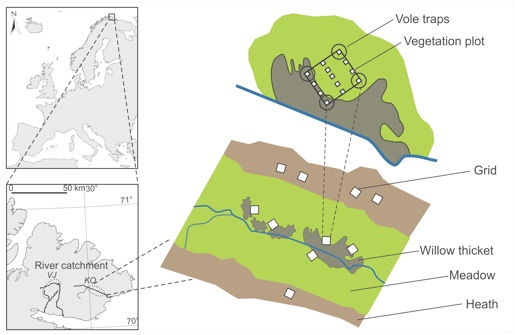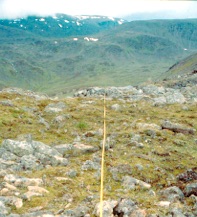study designs OBSERVATIONAL STUDIES

Study design applied in
OBSERVATIONAL STUDIES

In these studies we observe changes along existing gradients
in for example temperature, herbivore densities, habitat fragmentation or bedrock types.

Location of the study area on riparian sediment plains at altitudes between 110 and 290 m above sea level on the Varanger Peninsula (70° N), eastern Finnmark, northern Norway, and a schematic indication of how sampling units were arranged hierarchically for sampling of spatial configuration of tall shrub patches (dark green) and the diversity of the herbaceous vegetation (olive green). Within both of the two river catchments (Komagdalen, KO; Vestre Jakobselv, VJ), tall shrub patches of willow were found in three distinct sections. Tall shrub patch configuration was sampled in 1-ha units within the sections. In the centre of these units, diversity of the herbaceous vegetation was sampled in grids of 15 m x 15 m. One side of the grids was aligned to the tall shrub patch edge. Herbaceous vegetation diversity was quantified in 13 plots spread within each grid at distances of 0, 7.5, and 15 m from the tall shrub patch edge.

Our aim is to stretch our study designs over landscapes and regions that are relevant for our predictors (such as large herbivores or climate gradients). We often find idiosyncratic responses to our predictors along these scales.
Way of choosing study units within a study design may also have consequences to the outcome of the study. We therefore advocate formal rules for choosing study units in order to at least make all choices transparent to fellow researchers and other people interested in the study outcome.
We believe knowledge covering such scales is a must when combining future research with monitoring and management.

On our study design pages you will also find examples of our
QUASI-EXPERIMENTAL or EXPERIMENTAL study designs.

